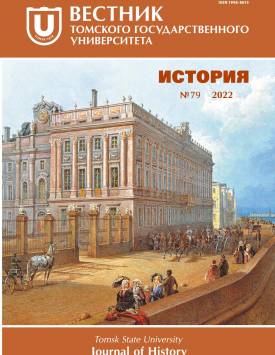About the mechanism of Soviet economic and political dissemination into Xinjiang (1931-1940)
The article gives a detailed analysis of foreign policy of USSR in respect of Chinese province Xinjiang in 1931-1940. The main objective of the research is to analyze political arrangement expansion of Soviet influence in East Turkestan, as well as to examine determinants which assure a powerful position in Xinjiang during the second half of the 1930s. It is based on academic works of Soviet, Russian and foreign historians which were published in the documents from the State Archive of the Russian Federation. Main political methods of Moscow state apparatus are considered in the paper. The factual and official political lines from People's Commissariat of Foreign Affairs of USSR are compared. Moreover, the situation with International News Agencies in North-western China is described. During 1931-1940 USSR pursued a policy of economic and political penetration in Xinjiang. The Government of the Soviet Union took advantage of a situation in which the Republic of China was weak and, with the support of the local administration of the USSR, expanded its influence over the zone. The course was conducted into four groups. The first was military intervention and the cessation of protests by Muslim radicals in the province. Secondly, Soviet state organized the State security organs similar to those of USSR. Furthermore, Soviet military advisers always attended in Urumqi. Thirdly, Soviet Union implemented communist ideals of socialist or national equalities. Ideology work was led among the Government forces and the civilian population. Fourthly, a number of trade contracts raised in East Turkestan and the Soviet state. Soviet support helped to strengthen the regime of Sheng Shmai in Northwest China. This led to the strengthening of Urumqi’s economic and political dependence on Moscow. The growing influence of the USSR in the region was accompanied by the dissemination of information in world news agencies about the USSR’s attempts to "Sovietize" and separate the province from China. With Japan’s outbreak of full-scale warfare in central China in 1937, Xinjiang became an exceptionally important transit region for the transport of arms and military equipment to the People’s Revolutionary Army.This forced Chiang Kai-Shek to reconcile with Soviet presence in East Turkestan. This mechanism of bilateral relations allowed Moscow to maintain its influence in Xinjiang until the early 1940s. The authors declare no conflicts of interests.
Keywords
foreign policy, Soviet influence, USSR, Xinjiang, East TurkestanAuthors
| Name | Organization | |
| Volkova Irina V. | Amur State University of Humanities and Pedagogy | mleel992@mail.ru |
| Ivanov Valery V. | Amur State University of Humanities and Pedagogy | sir.vv-ivanov@yandex.ru |
References

About the mechanism of Soviet economic and political dissemination into Xinjiang (1931-1940) | Tomsk State University Journal of History. 2022. № 79. DOI: 10.17223/19988613/79/14
